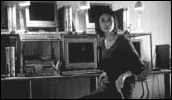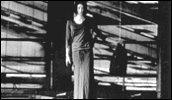Pulse
- Year
- 2001
- Original title
- Kairo
- Japanese title
- 回路
- Director
- Cast
- Running time
- 117 minutes
- Published
- 21 June 2001



by Tom Mes
It's interesting to think what the significance of the horror genre is in cinema history. It's a genre which is as old as cinema itself. Although the tradition of the fantastique is usually seen as originating with the fanciful works of "cinemagician" Georges Méliès, it was his more realism-inclined fellow pioneers the Lumière brother who struck into the hearts of the first cinema audiences with their l'Arrivée d'un train à la Ciotat (1895). It might be seen as quite a leap to think of that minute-long recording of an arriving locomotive as a horror film by today's standards, but it did exactly what the horror genre is meant for: it scared the audience. This is the definition of horror in its purest form, a definition which has become a bit muddled from decades of abuse at the hands of inferior talents and profit-minded entrepreneurs.
Where the cheaply made B-horror quickies of the 1950s and 60s turned horror into a laughing stock, the legacy of the 70s and 80s, with their increasingly graphic portrayal of violence, added the notion that horror is all about blood and guts. And so cinema's oldest genre has come to achieve its position at the bottom of the ladder of respectability, misunderstood by everyone but a tiny handful of persevering filmmakers and disowned, as John Bowen recently pointed out in his always entertaining Bowen's Basement column in Rue Morgue magazine, by many of those who dabbled in more "classy" offshoots.
One of the most persevering of true believers is Kiyoshi Kurosawa. As his breakthrough film Cure (1997) proved, he is a man who not only knows what the term "horror cinema" implies, he has the talent to put horror on screen in its purest form - and in the process prove that a horror film can indeed be a work of art without the need to disavow the label. His approach favours the classic tools of the cineaste (cinematography, composition, lighting, editing, and sound) over special effects and combines those with highly effective storytelling that is rich in themes and significance.
Pulse is further proof of his abilities. Its story premise of a succession of suicides by young internet users becomes a treatise on contemporary solitude, isolation, and discommunication. Though computers and technology form the central point of the story, Kurosawa steers clear of the technophobia manifested in such related American works as Demon Seed (1977 - Donald Cammell), War Games (1983 - John Badham), The Lawnmower Man (1992 - Brett Leonard), or The Matrix (1999 - Wachowski bros.). The horror lies not in the threat of an almighty, autonomous technology that might take over or destroy our lives, but in the effects that the presence of technology, and in particular communications technology like the internet and mobile phones, has on our lives and our ways of communicating as human beings in society.
Kurosawa emphasises his bleak view by setting the story in a Tokyo that is desolate, cold, and run-down; a city of loneliness and impending doom that looks like it could fall apart and crumble any day. Its interiors are filled with shadows that could hide the most terrible things. When light does penetrate, it has an unnatural bleakness, as if the sun had ceased to send its comforting warmth. Even when the characters walk around in short sleeves it seems as if they are surrounded by cold. After witnessing all of this, it's not much of a surprise to see the apocalypse that comes in the film's finale. But its vision of deserted streets full of burning buildings and dead bodies (one step beyond the similar ending of Kurosawa's 1999 film Charisma) might not be a true apocalypse at all, but rather the symbol of ultimate dehumanised solitude.
Kurosawa's way of employing backgrounds as part of the on-screen actions deserves special mention. It is at once strikingly effective and deceptively simple, aided immensely by the camerawork of Junichiro Hayashi and Meicho Tomiyama's lighting design. Rarely does the director use the narrow close-up lens so often employed in American films, which keeps backgrounds out of focus and isolates the character - or rather the star - from his environment. In Kurosawa's films, character and environment are inseparable, since the characters are defined by their surroundings. The significance of these surroundings goes far beyond being a simple décor, to the point of becoming characters in their own right, breathing, moving, and living, as unpredictable as any of the human characters on screen. In Pulse, when people disappear, they leave silhouet-like stains on walls, as if the environment swallowed them up. (Such black stains were in actual fact one of the very real effects of the atomic bombs on Hiroshima and Nagasaki.)
Pulse is a triumph of effective filmmaking, made by a director who should be considered one of the most important filmmakers to work in the horror genre, in Japan or elsewhere. If only he could have spared us the jarring pop song over the end credits. But that's the price to pay for making a big budget studio movie, I guess.